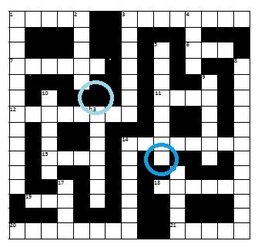 My first attempts at setting involved pencils and graph paper.
My first attempts at setting involved pencils and graph paper. | I assumed that this instinct had just passed me by. Unlike my sister, the architect, or my brother who designs video games, I've never cared about the inner workings of things. Then I started solving cryptic crosswords. Out of nowhere, that engineering curiosity kicked in. No sooner had I gotten the hang of solving the puzzles than I wanted to figure out how to make one myself. |
But despite searching high and low for the rules that govern the setting of cryptics, I came up empty-handed. I could find no books or blogs on the subject; just a small community of cryptic crossword aficionados on twitter who occasionally share clues. Too impatient to wait for the right lesson to come along, I sat down with a few Fraser Simpson puzzles, a coffee, and my newfound engineer's curiosity, and set to work figuring out for myself how his grids and clues are structured.
| I have made twenty puzzles since then. Interestingly, the more I strive to learn, the more I connect with people who can help. For example, a veteran setter I found on twitter turned me on to puzzle-making software. (Making my first few puzzles with graph paper, a pencil, and a heavy-duty eraser was incredibly arduous.) My question about minimum answer length was also recently answered: although Fraser Simpson's shortest is four letters, this cannot be a universal rule because I recently saw a clue from The Times with a three-letter answer. |



 RSS Feed
RSS Feed
